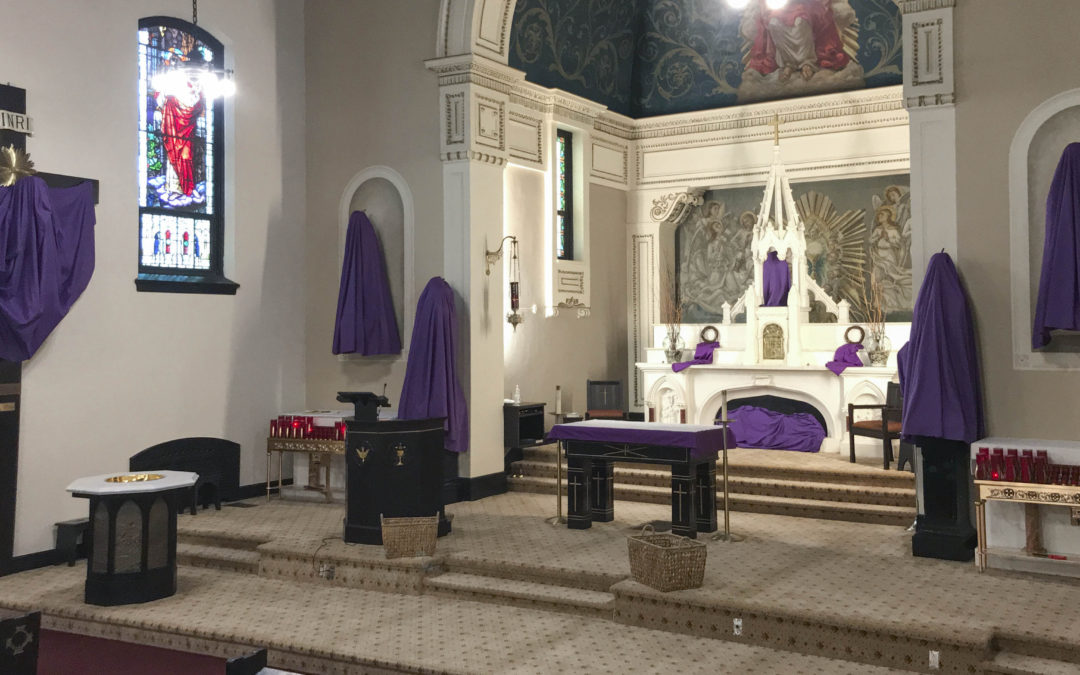Dear Friends,
If you walked into the church this weekend, then you noticed that the statues and images are covered – at least the ones we can reach! You may be wondering why the parish does this the last couple weeks of Lent. We might first ask why we have statues and images to begin with.
Sacred images serve many purposes. While sacred images in a Catholic church are never to be objects of worship in themselves, they point to spiritual realities beyond themselves and beyond even the subjects they depict. Any sacred art within a church, besides the individual devotional service they serve, form part of the function of giving us an image of what the church truly is meant to be. Liturgical imagery unites our earthly worship with that of which it is a foretaste and a participation: the heavenly liturgy. The image of Christ the King, along with the angels dancing below, on our ceiling above the back altar make that clear. Our Eucharistic celebrations are the place where earth and heaven touch and reveal to us what heaven is going to be like. The images of the saints in churches establish visually what the words of the liturgy proclaim when we say “…with all the hosts and Power of heaven…”
Here is what the Church says in the General Instructions of the Roman Missal:
In the earthly Liturgy, the Church participates, by a foretaste, in that heavenly Liturgy which is celebrated in the holy city of Jerusalem, toward which she journeys as a pilgrim, and where Christ is seated at the right hand of God; and by venerating the memory of the Saints, she hopes one day to have some share and fellowship with them. Thus, in sacred buildings, images of the Lord, of the Blessed Virgin Mary, and of the Saints, in accordance with most ancient tradition of the Church, should be displayed for veneration by the faithful and should be so arranged so as to lead the faithful toward the mysteries of faith celebrated there. Care should, therefore be taken that their number not be increased indiscriminately, and moreover that they be arranged in proper order so as not to draw the attention of the faithful to themselves and away from the celebration itself.
So, why cover them up the last weeks of Lent? During Lent we fast from things which in themselves are good gifts of God in order to focus more intently on the giver and appreciate them more. And we are reminded of our unworthiness to receive those gifts in preparation for the annual celebration of the Paschal Mystery which makes us worthy. During Lent, in worship, we forego expressions of joy and the fullness of God’s glory by suspending the Gloria and the Alleluia before the Gospel. In Lent, we reflect on presence through absence.
Veiling images that represent the fullness of God’s glory and images of the heavenly worship in which all the saints in glory participate is the same as omitting the Gloria. It is also fitting that during the days when we celebrate both the institution of the Eucharist and the sacrifice it remembers, we focus on the centrality and primacy of the Eucharist celebration. Veiling devotional images in the church reinforces the visual centrality of the altar.
At a very basic level, the veils provide simplicity. The veils used are simple and are solid violet to be unified with the vestments. They should not draw attention to themselves. Veiling provides a visual expression to accompany the other Lenten practices of fasting and abstinence.
I hope that helps you to understand why your favorite statue is covered up! May the covering help you to focus a bit more devoutly on the great giver of all good gifts – God.
Peace,
Fr. Damian



